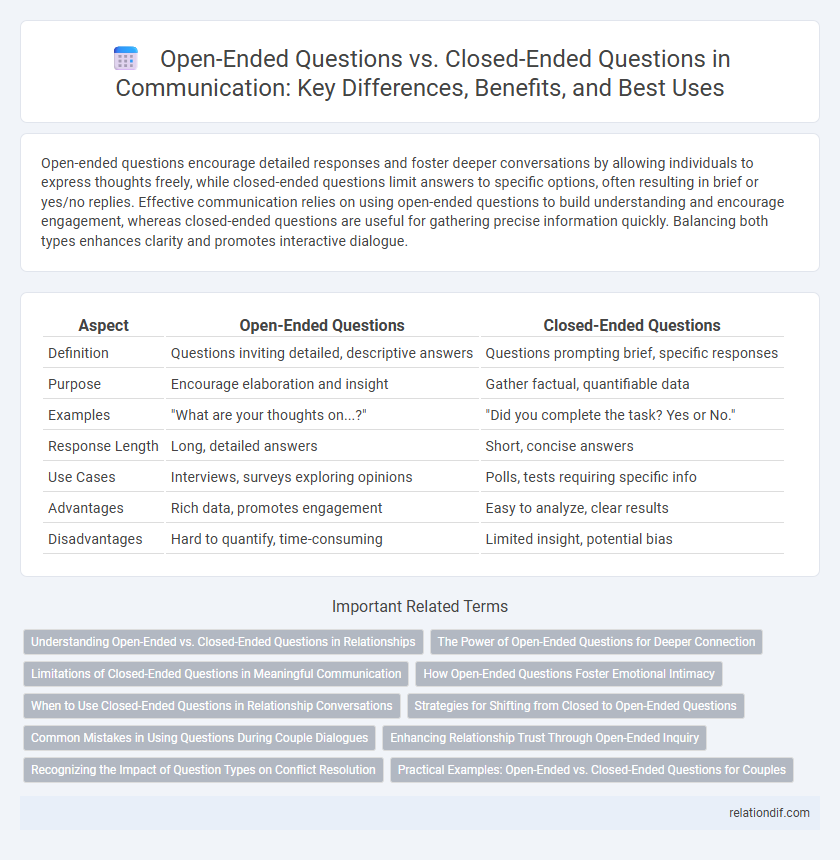Open-ended questions encourage detailed responses and foster deeper conversations by allowing individuals to express thoughts freely, while closed-ended questions limit answers to specific options, often resulting in brief or yes/no replies. Effective communication relies on using open-ended questions to build understanding and encourage engagement, whereas closed-ended questions are useful for gathering precise information quickly. Balancing both types enhances clarity and promotes interactive dialogue.
Table of Comparison
| Aspect | Open-Ended Questions | Closed-Ended Questions |
|---|---|---|
| Definition | Questions inviting detailed, descriptive answers | Questions prompting brief, specific responses |
| Purpose | Encourage elaboration and insight | Gather factual, quantifiable data |
| Examples | "What are your thoughts on...?" | "Did you complete the task? Yes or No." |
| Response Length | Long, detailed answers | Short, concise answers |
| Use Cases | Interviews, surveys exploring opinions | Polls, tests requiring specific info |
| Advantages | Rich data, promotes engagement | Easy to analyze, clear results |
| Disadvantages | Hard to quantify, time-consuming | Limited insight, potential bias |
Understanding Open-Ended vs. Closed-Ended Questions in Relationships
Open-ended questions foster deeper understanding and emotional connection by encouraging thoughtful, detailed responses and active listening, which enhances communication quality in relationships. Closed-ended questions, offering brief or single-word answers, are useful for clarifying specific facts but limit expressive dialogue and risk creating emotional distance. Balancing both question types strategically supports healthier interpersonal dynamics by promoting transparency and empathy between partners.
The Power of Open-Ended Questions for Deeper Connection
Open-ended questions foster deeper connections by encouraging detailed responses and thoughtful dialogue, promoting active listening and empathy. Unlike closed-ended questions that limit answers to "yes" or "no," open-ended queries facilitate understanding of emotions, motivations, and perspectives. This conversational technique enhances relationship building, trust, and conflict resolution across personal and professional communication.
Limitations of Closed-Ended Questions in Meaningful Communication
Closed-ended questions restrict responses to predefined options, limiting the depth of information exchanged and impeding nuanced understanding in meaningful communication. These questions often inhibit elaboration, reducing the opportunity for open dialogue and diminishing the exploration of complex ideas or emotions. Relying heavily on closed-ended questions can lead to superficial interactions, preventing the development of authentic connections and comprehensive insights.
How Open-Ended Questions Foster Emotional Intimacy
Open-ended questions encourage deeper emotional sharing by inviting elaborate responses and personal reflection, fostering trust and vulnerability in communication. They create a safe space for individuals to express feelings, thoughts, and experiences beyond yes or no answers, enhancing emotional connection. This approach nurtures empathy and understanding, essential components for building strong interpersonal relationships.
When to Use Closed-Ended Questions in Relationship Conversations
Closed-ended questions are effective in relationship conversations when clarity and direct information are needed, such as confirming specific details or understanding partner preferences quickly. They help minimize misunderstandings by eliciting precise yes/no or choice-based answers, ensuring focused communication. Using closed-ended questions strategically supports efficient problem-solving and decision-making during emotionally charged discussions.
Strategies for Shifting from Closed to Open-Ended Questions
Shifting from closed to open-ended questions enhances communication by encouraging detailed responses and deeper engagement. Techniques include rephrasing yes/no questions into prompts like "Can you describe..." or "What are your thoughts on...," which invite elaboration. Practicing active listening and allowing pauses after questions also fosters a more open dialogue, enabling meaningful information exchange.
Common Mistakes in Using Questions During Couple Dialogues
Common mistakes in using questions during couple dialogues include relying excessively on closed-ended questions, which limit emotional expression and hinder deeper understanding. Open-ended questions are often underutilized, reducing opportunities for meaningful communication and connection. Failing to balance question types can lead to frustration, misinterpretation, and unresolved conflicts within relationships.
Enhancing Relationship Trust Through Open-Ended Inquiry
Open-ended questions encourage detailed responses that foster deeper understanding and emotional connection, essential for building trust in relationships. Unlike closed-ended questions, which limit answers to yes or no, open-ended inquiry promotes transparency and active listening, strengthening interpersonal bonds. This approach supports a more authentic dialogue, reducing misunderstandings and enhancing mutual respect.
Recognizing the Impact of Question Types on Conflict Resolution
Open-ended questions foster dialogue by encouraging detailed responses and promoting understanding, which helps de-escalate conflicts through empathy and collaboration. Closed-ended questions often limit communication to yes/no answers, which can create barriers and intensify misunderstandings. Recognizing how open-ended inquiries facilitate problem-solving while closed formats may hinder resolution is crucial for effective conflict management.
Practical Examples: Open-Ended vs. Closed-Ended Questions for Couples
Open-ended questions such as "How do you feel about our weekend plans?" encourage deeper emotional sharing and foster meaningful dialogue between partners. Closed-ended questions like "Do you want to go out on Saturday?" typically elicit brief, factual responses that can clarify specific choices but may limit conversation depth. Couples benefit from balancing these question types to enhance understanding and resolve conflicts effectively.
open-ended questions vs closed-ended questions Infographic

 relationdif.com
relationdif.com